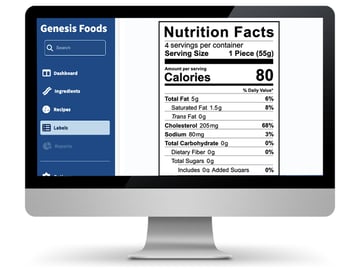Earlier this year, the COVID-19 Public Health Emergency ended, and the FDA identified 22 COVID-era temporary guidance documents that will expire on November 7, 2023. One of those documents was focused on temporary flexibility around menu labeling compliance. With the deadline approaching, restaurants and food establishments that fall under this regulation must assess their menu labels for compliance.
The FDA's Menu Labeling Regulations require certain restaurants and other food establishments to provide calorie and other nutrition information for standard menu items. The regulations also aim to provide consumers with accurate and easily accessible information about the nutritional content of the food they consume.
Let’s review some of the best practices around menu labeling so you can accurately prepare for compliance.
1. Menu Labeling Regulatory Review
In addition to Federally mandated regulatory requirements for covered establishments, there are additional state and local requirements that might impact your business. For covered establishments with 20 or more locations, under the same name, these establishments must display calorie information for standard menu items and must provide access to nutrition information.
As explained by the FDA, the rule requires:
- Covered establishments include restaurants (both quick service and sit-down), grocery and convenience stores, food takeout facilities, entertainment venues, cafeterias, coffee shops, superstores, and some managed food service operations.
- Calories must be displayed on menus and menu boards and for food on display and self-service. A Succinct Statement regarding suggested caloric intake and a statement that Additional Nutrition Information is Available Upon Request must be included on menus and menu boards.
- Additional Nutrition Information must be available upon customer request on the premises of the covered establishment. Customers cannot be directed to a website; it must be available in print or digitally onsite via an electronic device that can be shown to the customer at the point of purchase. The information must include the nutrients required on the Nutrition Facts label with the exception of vitamins and minerals. Elements include: Total Calories, Total Fat, Saturated Fat, Trans Fat, Cholesterol, Sodium, Total Carbohydrate, Dietary Fiber, Sugars, and Protein.
- Additionally, Calories from Fat is written in the original regulation, but it is no longer required on Nutrition Facts labels. In a 2018 FDA Guidance document, Calories from Fat were addressed: "we do not intend to enforce this regulatory provision as it applies to 'Calories from Fat.'"
Now that the temporary policy is lifted, establishments will want to take time to review the regulations, determine if the business meets the criteria for being a “covered establishment,” and take action to ensure compliance.
2. Gather Nutritional Information for Your Menu Items
FDA regulations require that businesses provide nutritional information for all standard menu items, as well as variations of those items (combination meals and variable menu items, for example). However, some items, such as condiments and custom orders, are exempt from menu labeling regulations.
However, this brings up unique challenges for certain establishments. “A restaurant that serves pizza could offer a wide range of variations in terms of what a customer chooses to put on their pizza,” shared Megan Murphy on our latest Transparency Talk podcast episode. The FDA has released a few clarifying guidance documents on how to label food variations on menu boards.
Once you are comfortable with the Menu Labeling Regulation requirements, you can begin to document the necessary information. Oftentimes restaurants will need to use a variety of techniques and tools to calculate the nutritional value of their menu items.
- Ingredient Supplier Data: Obtain nutritional information from your suppliers for all of your ingredients that make up your menu items.
- Nutritional Analysis Software: Various nutrition analysis software programs are available for restaurants. These user-friendly tools allow you to input the ingredients and quantities from your supplier spec sheets, lab analysis data, or by using the database items available in the software. Subsequently, the software calculates the nutritional content of your recipes and menu items based on the provided ingredients. Some platforms can generate nutrition labels for your menu items, which is particularly helpful when providing information to customers or for complying with regulations.
- Lab Analysis: Lab analysis may be required especially when dealing with complex menu items, particularly those involving fried foods. For fried items, the cooking process can introduce significant variations in nutritional content due to factors such as oil absorption, moisture loss, and the specific cooking duration. These variables can be hard to account for accurately without scientific analysis.
Beyond crafting your own menu labels through software or online tools, you can also reach out to regulatory experts to review your menu, analyze recipes, and create menu nutrition information and reports. They can guide you through the process of gathering necessary data and conducting the analysis. They understand the legal requirements and can assist you in creating compliant menu labels.
3. Display Caloric Information on Menu Boards and Online
Once you have obtained the essential nutritional analysis for your menu items, the next crucial step is effectively conveying this information to customers. This involves adding the required information onto menu boards and online ordering systems, ensuring that patrons have easy access to nutritional details when making their dining choices. Be sure to consider the following:
-
Layout and Design: Don’t forget to consider layout and design when displaying nutritional data on your menu. The information should be presented in a clear and easily readable format.
-
Font and Size: Use a legible font and an appropriate size to ensure that customers can readily digest the information. FDA regulations require Calories to be displayed prominently, in a size and typeface that is at least as prominent as the name or price of the menu item.
-
Menu Board and Website Integration: Work closely with your menu board and/or website designers to integrate the nutritional data into your existing layout. Ensure that the data mirrors what's displayed on the physical menu boards. Be sure to include the Succinct Statement and Additional Nutrition Information Available Upon Request requirements per Menu Labeling regulations. You can also harness an automated program for your nutritional data that will update ingredients and recipe data unattended, like the Genesis Foods API, to integrate with other systems. (You can read more about the benefits of Genesis API in our Wegmans customer story.)
4. Train Your Staff
As you set up your menu labeling offerings, it is imperative you also inform all your employees about the regulations and how to handle customer requests for additional nutritional information. If you offer a brochure or printed menu with Additional Nutritional Information, your employees should know where to find those copies, where to print off more if you run out, or how to show customers digitally the required information inside the covered establishment. This will help ensure your business is accurately offering customer information and following the FDA’s guidelines.
5. Maintain Regular Menu Updates as Needed
Ingredients and suppliers can change frequently, which means your menu labels may need to change as well. “Managing updates is often one of the biggest challenges for restaurants,” Megan Murphy shared on Transparency Talk. “There can be changes in suppliers or reformulation, or a company changes the size of a cup, all of which can impact the final caloric number.”
As a result, it’s essential to regularly review your nutritional data for accuracy. Additionally, if a supplier or ingredient changes, make sure you’re updating your nutritional data accordingly as a part of your supplier updating or reformulation process.
The FDA requires any change should be immediately updated. If your suppliers change or update nutritional data frequently, or your recipe build or amounts change, you may find yourself constantly updating data. “If a restaurant has an inaccurate caloric number, the FDA may consider that as ‘misbranded’ and you could see fines or violations of federal law,” Megan said. “It can be expensive to switch out menu updates, but the FDA has provided some guidance on using stickers to replace numbers on boards, or other means to meet compliance.”
Noncompliance can be costly, Megan emphasized: “Restaurants could be called out of compliance by the FDA if menu items are incorrect, which could result in fines and criminal penalties. While it’s a financial impact, it could also result in a brand impact if it becomes news.”
Label Those Menus with Expert Assistance
Adhering to the FDA’s Menu Labeling regulation is important for restaurants and food service establishments that meet the requirements. Utilize this November 7, 2023, compliance date as an opportunity to review processes and ensure that your menu, menu boards, and additional nutrition information is accurate and up to date. Remember, compliance is not a one-time task; it requires ongoing dedication and commitment to meeting regulatory standards and promoting informed consumer choices.
If you’re looking for menu labeling guidance or want to explore our menu labeling solutions, reach out to our team today to start the conversation. And if you’re curious to learn more about the Genesis Foods advantage for restaurants, read our customer story.
Tag(s):
Food Labeling
,
Food Industry
,
Food Safety
,
Industry Regulations
,
Restaurants
,
FDA
,
Transparency
Other posts you might be interested in
View All Posts
Product Formulation
9 min read
| May 10, 2023
How Genesis Foods Can Accelerate Accurate Nutrient Calculations
Read More
8 min read
| May 16, 2023
How to Increase Speed to Market for New Recipes and Food Products
Read More
Food Labeling
10 min read
| May 2, 2023

